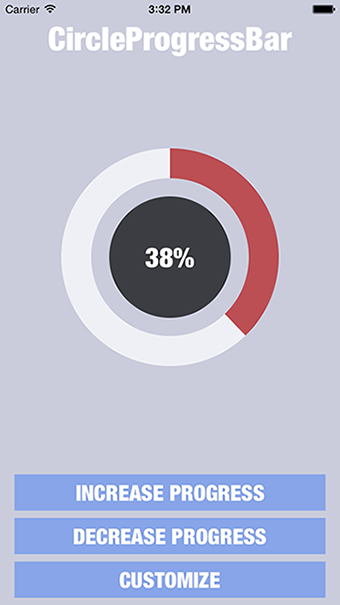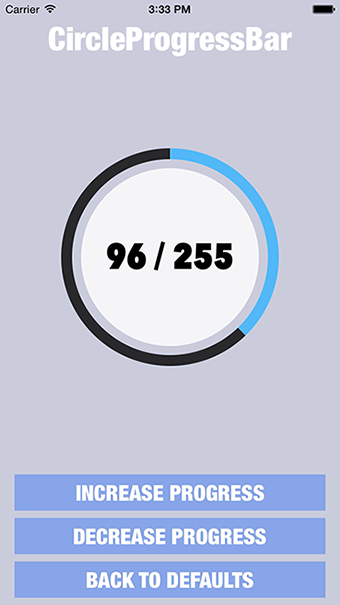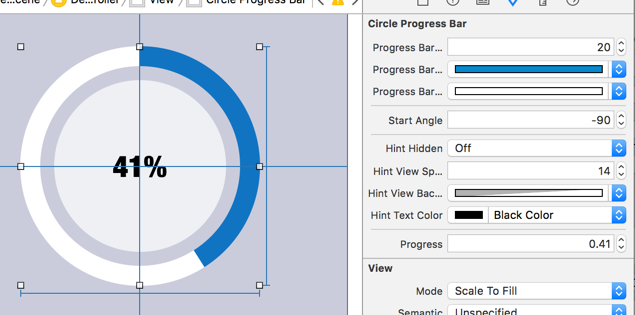iOS Circle Progress Bar alternatives and similar libraries
Based on the "Activity Indicator" category.
Alternatively, view iOS Circle Progress Bar alternatives based on common mentions on social networks and blogs.
-
SkeletonView
☠️ An elegant way to show users that something is happening and also prepare them to which contents they are awaiting -
SwiftSpinner
A beautiful activity indicator and modal alert written in Swift (originally developed for my app DoodleDoodle) Using blur effects, translucency, flat and bold design - all iOS 8 latest and greatest -
FillableLoaders
Completely customizable progress based loaders drawn using custom CGPaths written in Swift -
YLProgressBar
UIProgressView replacement with an highly and fully customizable animated progress bar in pure Core Graphics -
MBCircularProgressBar
A circular, animatable & highly customizable progress bar from the Interface Builder (Objective-C) -
PageControls
This is a selection of custom page controls to replace UIPageControl, inspired by a dribbble found here: https://dribbble.com/shots/2578447-Page-Control-Indicator-Transitions-Collection -
StackViewController
A controller that uses a UIStackView and view controller composition to display content in a list -
AlamofireNetworkActivityIndicator
Controls the visibility of the network activity indicator on iOS using Alamofire. -
Skeleton
✨ An easy way to create sliding CAGradientLayer animations! Works great for creating skeleton screens for loading content. -
BigBrother
DISCONTINUED. Automatically sets the network activity indicator for any performed request. -
StepProgressView
Step-by-step progress view with labels and shapes. A good replacement for UIActivityIndicatorView and UIProgressView. -
IHProgressHUD
A clean and lightweight progress HUD based on SVProgressHUD, converted to Swift with the help of Swiftify. -
AudioIndicatorBars
AIB indicates for your app users which audio is playing. Just like the Podcasts app. -
KYNavigationProgress
Simple extension of UINavigationController to display progress on the UINavigationBar. -
StatusBarOverlay
StatusBarOverlay will automatically show a "No Internet Connection" bar when your app loses connection, and hide it again. It supports apps which hide the status bar and The Notch
InfluxDB - Power Real-Time Data Analytics at Scale

* Code Quality Rankings and insights are calculated and provided by Lumnify.
They vary from L1 to L5 with "L5" being the highest.
Do you think we are missing an alternative of iOS Circle Progress Bar or a related project?
README
CircleProgressBar
Circle Progress Bar iOS Control.
Require iOS 7.0+ or tvOS 9.0+


Installation
You can install this control in two ways:
- Using CocoaPods:
pod 'CircleProgressBar', '~> 0.32’
- Manually:
Download source from this repository and copy CircleProgressBarDemo/CircleProgressBar folder to your project.
Don't forget to add UIKit and QuartzCore frameworks to your project.
How to use
NOTE: If you installed this control manually - please be sure that you've added UIKit and QuartzCore frameworks to your project.
NOTE: If you're using rectangular view for CircleProgressBar control instead of square, ProgressBar will fit available area and will be drawn in center of it.
NOTE: If you're using swift, be sure to add import CircleProgressBar to source file where you're using it.
You can simply add UIView in Interface Builder to your controller and change it's class to "CircleProgressBar" (overridden initWithCoder method will be called) or create CircleProgressBar programmatically using init or initWithFrame methods.
Using Interface Builder you'll take advantage of Xcode 6 new live rendering feature to customize control according to your needs on the fly (will be explained below in "Customization" section).
To change progress, simply call "setProgress:animated:" method of CircleProgressBar instance:
Objective-c:
[_circleProgressBar setProgress:(CGFloat)progress animated:(BOOL)animated];
Swift:
circleProgressBar.setProgress(CGFloat, animated: Bool)
or "setProgress:animated:duration:" method to define custom animation time:
Objective-c:
[_circleProgressBar setProgress:(CGFloat)progress animated:(BOOL)animated duration:(CGFloat)duration];
Swift:
circleProgressBar.setProgress(CGFloat, animated: Bool, duration: CGFloat)
To check if there is ongoing animation use isAnimating property.
To stop an ongoing animation, you can use stopAnimation method. In this case it will set the progress to animation end value:
Objective-c:
[_circleProgressBar stopAnimation];
Swift:
circleProgressBar.stopAnimation()
Customization
CircleProgressBar provides many customization properties:
// Progress Bar Customization
@property (nonatomic) CGFloat progressBarWidth;
@property (nonatomic) UIColor *progressBarProgressColor;
@property (nonatomic) UIColor *progressBarTrackColor;
@property (nonatomic) CGFloat startAngle;
// Hint View Customization (inside progress bar)
@property (nonatomic) BOOL hintHidden;
@property (nonatomic) CGFloat hintViewSpacing;
@property (nonatomic) UIColor *hintViewBackgroundColor;
@property (nonatomic) UIFont *hintTextFont;
@property (nonatomic) UIColor *hintTextColor;
Using these customization properties you can define Progress Bar's width, color of filled part, color of empty part, Progress Bar's start angle, Hint View's spacing (between progress bar and hint view), background color, hint text color and hint text font.
If you want to hide HintView you can simply set hintHidden property to NO.
To customize text inside HintView you can simply set TextGenerationBlock:
Objective-c:
[_circleProgressBar setHintTextGenerationBlock:(StringGenerationBlock)generationBlock];
Swift:
circleProgressBar.setHintTextGenerationBlock(generationBlock: StringGenerationBlock!)
For example this way:
Objective-c:
[_circleProgressBar setHintTextGenerationBlock:^NSString *(CGFloat progress) {
return [NSString stringWithFormat:@"%.0f / 255", progress * 255];
}];
Swift:
circleProgressBar.setHintTextGenerationBlock { (progress) -> String? in
return String.init(format: "%.0f / 255", arguments: [progress * 255])
}
If you want to use NSAttributedString you can set instead HintAttributedGenerationBlock:
Objective-c:
[_circleProgressBar setHintAttributedGenerationBlock:(AttributedStringGenerationBlock)generationBlock];
Swift:
circleProgressBar.setHintAttributedGenerationBlock(generationBlock: AttributedStringGenerationBlock!)
If you using Interface Builder, you can take an advantage of Xcode 6 live render with IBDesignable and IBInspectable features to customize control:

License (MIT)
Copyright (c) 2015-2018 Andrew Cherkashyn
Permission is hereby granted, free of charge, to any person obtaining a copy of this software and associated documentation files (the "Software"), to deal in the Software without restriction, including without limitation the rights to use, copy, modify, merge, publish, distribute, sublicense, and/or sell copies of the Software, and to permit persons to whom the Software is furnished to do so, subject to the following conditions:
The above copyright notice and this permission notice shall be included in all copies or substantial portions of the Software.
THE SOFTWARE IS PROVIDED "AS IS", WITHOUT WARRANTY OF ANY KIND, EXPRESS OR IMPLIED, INCLUDING BUT NOT LIMITED TO THE WARRANTIES OF MERCHANTABILITY, FITNESS FOR A PARTICULAR PURPOSE AND NONINFRINGEMENT. IN NO EVENT SHALL THE AUTHORS OR COPYRIGHT HOLDERS BE LIABLE FOR ANY CLAIM, DAMAGES OR OTHER LIABILITY, WHETHER IN AN ACTION OF CONTRACT, TORT OR OTHERWISE, ARISING FROM, OUT OF OR IN CONNECTION WITH THE SOFTWARE OR THE USE OR OTHER DEALINGS IN THE SOFTWARE.
*Note that all licence references and agreements mentioned in the iOS Circle Progress Bar README section above
are relevant to that project's source code only.

